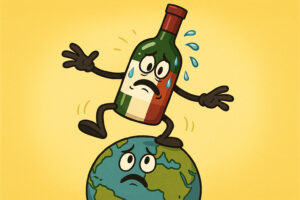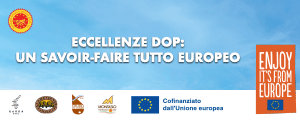After more than a year since the beginning of the pandemic, Italian wine has to deal with a market of consumption that has been turned upside down, but which looks forward to a new start, starting with the reopening of bars and restaurants on April 26th. New normality in which online sales are destined to remain a part for a long time to come, aiming for a market share of 10%, but also a relationship between the consumer and wine that has been renewed and regenerated by the home dimension. In this year, in fact, what saved the domestic market, more than e-shops, were large-scale distribution and wine shops, both able to remodel the offer and intercept the needs of wine lovers and housewives, as emerged from the webinar “The wine market after a year of pandemic” by Coldiretti, conducted by Riccardo Cotarella, president of Assoenologi and co-president of the Union Internationale des Oenologues, which was attended by Marco Magnacavallo, managing director of Tannico, Marcello Meregalli, head of the Meregalli Group, Giovanni Mantovani, director of Veronafiere, Alessandra Corsi, marketing director of Conad, Vincenzo Russo, Professor of Consumer Psychology and Neuromarketing at Iulm University in Milan, Francesco Ferreri of the National Wine Committee and member of the Coldiretti Council, and Ettore Prandini, president of Coldiretti.
“Large-scale distribution has replaced an important part of the consumption lost in out-of-home”, explains Alessandra Corsi, Conad marketing director. “Retail grew 11% in value and +7% in volume, thanks to quality wines and bubbles. Distributor brands and private labels grew in the same way, with Super (+14%) and Discount (+12%) posting the best figures, while large-scale distribution e-commerce even increased by 150%. Food, together with electronics (driven by smart working), is one of the few sectors growing. In 2020, there was an increase in per capita alcohol consumption of 3 liters compared to 2018 and 2019. People drank much more during meals (from 50% to 61% of Italians), paying more and more attention to quality, both to support Made in Italy and as a choice for their own well-being, both in retail, as shown by the increase in average prices, and in general”. One of the results, continues Alessandra Corsi, are the “gourmet dinners and comfort food even at home, which have increased the average price of the bottle in the cart. Italian style is strengthened, even in bubbles (+19%) that do better than Champagne. Retail grew 23% in 2021 compared to the first two months of 2020, when there was still no pandemic. In the second quarter, we expect a definite slowdown, due to reopenings, and we expect a nearly even summer season on 2020, while the last quarter will be difficult to replicate. Retail, for wine, it should be remembered, is worth 3 billion euros. There are three macro trends that we will take with us from this pandemic: consolidation of local and Italian products; reduction of domestic consumption in favor of consumption outside the home; attention to the quality of alcoholic products”, concludes the marketing director of Conad.
“Distribution has restarted very strong, we are closing a four-month period with a growth between +65% and +70%, above 2019 figures,” says Marcello Meregalli, at the head of Gruppo Meregalli, among the leaders in wine distribution. “Pre-Covid sales were related 45% to the off trade (restaurants) and 40% to the on trade (wine shops), in 2020 the off trade dropped to 23%, and in this early 2021 it’s dropping again, so we're hoping for stable reopenings. There are plenty of opportunities, however. Wine shops have given a great help, our wine shop in Monza has done +30%. We are less present in large-scale retail trade, where however our share goes up from 3 to 5%, with an average price that marks +11%: people spend in wine shop or in large-scale retail trade what they do not spend in restaurants”, says Meregalli. “Online is showing huge data globally, a bit less in the Italian market, which has gone from 3% to 7% by the end of 2020, but is heading towards 9% by the end of 2021. We think it’s going to normalize, but it’s a new normal, it's convenient, it offers a lot of products and white-glove service. We should expect a general repositioning, but many things will remain. Interesting, among the new things, how delicatessen and fruit and vegetable stores, delicatessens and butchers have returned to selling decidedly important bottles. It was something that had been lost, it is one more opportunity. Among young people there is a continuous search for information: it is good for us, because we had stopped on known brands and territories, losing a bit the passion for novelty. From May-June - continues Marcello Meregalli - we expect a boom in catering: last year from May 18 there was a crazy increase, and from June to September the hotellerie marked +25% on 2019. Online will normalize in numbers, but in Italy, it could be solidly worth 10%. Wine shops have been good at recycling themselves, even as advice points. Mixology, in addition to wine, has moved home, along with Whiskey, Rum and Cognac, in the name of drink quality. The average price is higher, and I believe it will stay that way: people have gotten used to drinking better. To be noticed - concludes Meregalli - two other trends. Wine as a hobby: the desire for training and courses on tasting and pairing is growing. And the weight of “green”: sustainability will be a compulsory choice for many companies, opening up to new consumption. And that also concerns packaging: Anglo-Saxon countries make 3 billion in sales from quality wine cans, a different market, but in a green container, for a different target. These are philosophies to be followed and that will bring changes, mostly positive”.
Vincenzo Russo, Professor of Consumer Psychology and Neuromarketing at the Free University of Languages and Communication Iulm in Milan, investigates, in a scientific way, the changes in consumer perspective. “The increase in the average price is not surprising: in a moment of difficulty, people are looking for something that can lift them up. More than thinking machines that get excited, we are emotional machines that think: the way we see the consumer has changed. We need to communicate fundamental and interesting elements, but it’s emotionally important to engage the consumer. 64% of consumers buy a product based on how attention-grabbing it is. On average, a purchase is decided in a few seconds, between 4 and 20 to choose what to buy, and if I can increase the visibility of a bottle by 10%, the probability of purchase rises up to 35%”, explains Professor Russo. “If it’s the label that sells the first bottle, it's the wine that sells the second, so you have to work on trust. There has been a collapse in consumer confidence in companies since 2005, reaching its peak in 2012. On its own, this is not much to say, but 58, as a level of trust, is very far from the European average of 90: Italians do not trust anything, neither politics nor companies. Consumers are characterized by uncertainty, fear and unpredictability, which lead to loss of control and disorientation, which exalt some values, such as human values and the rediscovery of the essential, which characterize the world of wine, however unable to communicate them. One of the strongest trends is the need of authenticity: consumers, affected by the “artificiality” of the virus, reject everything that is artificial and want to recover transparency, naturalness and authenticity. And then there is the theme of sociality: we are about to restart, and whoever wants to do wine tourism must be able to guarantee sociality in safety”, continues the Professor of Consumer Psychology and Neuromarketing. “This is the best time to invest in brand reputation: the consumer is asking the company to tell, not be silent, even in the way it treats employees. But also collaborate and co-participate: co-marketing is fundamental, as is offering solutions to consumer questions; we need to help solve problems, not just sell; and communicate with empathy. We must try to intercept these trends, knowing that communication has a fundamental impact on the perception of what we drink and eat. Empathic storytelling, in fact, makes consumers produce oxytocin, which makes them more “open”. If I say something convincing, can I change the taste of a wine? It seems so. The orbitofrontal cortex, which has to do with taste, is more active when I know that wine costs more, that it will seem better than a cheaper one, even if the wine is the same. It is the expectation to make us perceive a good product even better than it really is”, concludes Vincenzo Russo.
If there is a channel that comes out of this year strengthened, aware, solid, and in continuous expansion, this is the online, as told by Marco Magnacavallo, CEO of Tannico, from mid-2020 controlled - with a 49% share - by Gruppo Campari. “It’s been a particular year, what we've seen is that there have been two different approaches to restrictions: those who just kept on complaining and those who have innovated and changed. I’m talking about wineries, from the largest to the smallest. Those who moved, breaking the mould, got results and discovered a new way of talking to customers. I’m thinking of wineries, even well-known ones, and super premium wines that, if up to two years ago they looked at online with annoyance, in the last year they have changed their point of view. They broke the hesitations and stopped being afraid of the judgment and of the relationships with wine shops and sales network. I am not talking about Tannico, but about the direct sales channel, with which the winery can work and play together with the most lively wine lovers. It is a tool destined to become more and more important, and in this direction also goes the project of internationalization on the online in 20 foreign markets of 400 Italian wineries that we will do together with Ice in the next months”, explains Magnacavallo. “We doubled our sales, and in this first quarter, sales are still increasing, even compared to the first quarter of 2020. People who came online were comfortable with it alongside other channels. In the first part of the lockdown, between March and June 2020, there was a change in the consumption matrix: slightly lower average price, as a consequence of a higher frequency of consumption, and huge cut on bubbles, also because there was really little to celebrate at the time”, concludes the CEO of Tannico.
Finally, the link that binds all the protagonists of the supply chain, i.e., the great trade fair events that bring together producers and traders, starting with Vinitaly, a reference point for Italian wine and a great absentee from the scene, as Giovanni Mantovani, director of Veronafiere, recounts. “90% of companies miss the events in attendance, and 60% hope they can start again as soon as possible. We must respond with the strength and ability to adapt and find solutions. In harmony with everyone in the wine world, that’s what we’ve done, redesigning the strategy for the two-year period 2021/2022. Digital has represented a boom, both in business relations and sales, it has served to keep the sector alive, but the physical dimension of business is not replaced by the digital version”, Mantovani emphasizes. “The restart passes first of all from those markets that in these last six months have returned to the physical presence of the events. In November 2020 we were in China, at Wine to Asia, the first edition and first fair in 2020 dedicated to wine; in March there was Vinitaly Russia, with a part in Moscow and St. Petersburg; a few weeks ago Vinitaly China, in Chengdu, with 60 Italian companies, a very rich and well attended event; in June again in Shenzhen with Wine to Asia, at its second edition, in the largest exhibition space in the world: we are already over 400 companies, over half Italian. We are also working on an event on the other side of the world, in the USA, with the aim of realizing an event at the end of 2021, with a local partner”, continues the director of Veronafiere. “After the road map abroad, Opera Wine returns to Italy on June 19, an extraordinary and anthological edition, with 200 wineries selected by Wine Spectator, those selected at least once in the nine previous editions. “Opera Festival” opens, representing two Italian excellences that dialogue in Verona. In October, from 17 to 19, Vinitaly Special Edition, strongly B2B and international. We are working very hard with Ice Agency and many international operators to ensure maximum presence from international markets, with a very strong focus on the markets of the USA and Italy, which has suffered most in this period. In agreement with the entire wine sector, we will hold the States General, and Wine2Wine will also take place at the same time, offering physical and digital promotional tools. The novelty we are launching is VinitalyPlus, a meeting point between the community of producers and that of international operators, a sort of market place, but also a meeting place 365 days a year. The digital system of this platform will give us back in the form of data on what happens inside the fair event. The special edition will not be Vinitaly, which returns in the spring, but it is a way to get back to talking and seeing each other. The pandemic has taught us not to take anything for granted, to be flexible and to listen even more to companies, but also the importance of interpersonal relations”, concludes Giovanni Mantovani.
Ettore Prandini, president of Coldiretti, was the one who summed up and virtually closed the event. “The wine sector is fundamental for the restart. We are working to create the conditions to finally reopen the restaurants, at least outdoors. We are working to give the same opportunity to restaurants that do not have outdoor spaces, from June 1, also for an opening in the evening hours. There is also a wider work to be done on tourism: those who come to visit our territories become ambassadors of our wines and our varieties. It takes the commitment of the entire supply chain because working side by side we can give wine the right visibility, as demonstrated by the example of Conad in the large-scale retail trade. With the new president of Federdistribuzione, we will push for more and more space on the shelves for wine. Without forgetting the traditional channels, such as wine shops, alongside which we have fought to avoid early closures”. Speaking of e-commerce, Prandini resumes, “for us, it is still in its infancy in terms of growth and possibilities, and the figures for the beginning of 2021 prove it. E-commerce offers the possibility of being on the market to all wineries, even the smallest ones, with an additional channel. But today we also need to talk about logistics and infrastructure. Both digital, because fiber is now essential in order to use the most modern tools, and material, starting with ports. The possibility of having an agricultural and food hub in the Mediterranean, one in the South and one in the Adriatic is fundamental. And then connect the ports adequately to rail and air traffic. Compared to the data we represent, we are just at the beginning, this country, also in terms of exports, can do much more, we must be aware of it. We are already imagining what to do to restart, and I am thinking of wine tourism, which is what combines the beauty of the territories, internationalization and the quality of our products. In the 40 billion euro budget variance decided by the Government - concludes Prandini - we obtained the deduction for January for wine companies, we hope to be able to extend it also for the following months”.
Copyright © 2000/2025
Contatti: info@winenews.it
Seguici anche su Twitter: @WineNewsIt
Seguici anche su Facebook: @winenewsit
Questo articolo è tratto dall'archivio di WineNews - Tutti i diritti riservati - Copyright © 2000/2025


























































































































































































